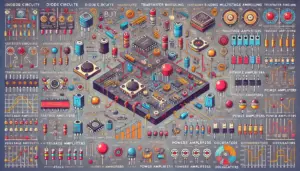AEC Notes Pdf | Analog Electronics Circuits Notes Latest Free Study Material Pdf VTU
Here you can download the Analog Electronics Circuits Notes VTU (AEC Notes PDF) as per the VTU Syllabus. Below we have listed all the links as per the modules.

Analog Electronics Circuits Notes | VTU AEC Notes Pdf
Overview of Analog Electronics Circuits Notes Pdf
The Analog Electronics Circuits notes cover all the essential topics and modules as per the VTU syllabus. These notes are designed to provide comprehensive coverage of the subject, helping students to grasp complex concepts with ease.
Analog Electronics Circuits is a crucial subject for students pursuing their B.Tech. Understanding these concepts is fundamental for anyone looking to excel in fields that involve electronic circuit design and analysis. The following sections offer detailed notes organized by module, ensuring that students can easily follow along and study each part of the syllabus thoroughly.


The following topics are covered in Analog Electronics Circuits handwritten Notes:
- Diode Circuits: Review of diodes as rectifiers, diode clipping, and clamping circuits.
- Transistor Biasing and Stabilization: Operating point, analysis, and design of fixed bias circuit, self-bias circuit, emitter stabilized bias circuit.
- Transistor at Low Frequencies: BJT transistor modeling, CE fixed bias configuration, voltage divider bias, emitter follower, CB configuration, collector feedback configuration, analysis using h-parameter model.
- Multistage Amplifiers: Cascade and cascade connections, Darlington circuits, feedback concept, practical feedback circuits.
- Power Amplifiers: Analysis and design of different power amplifiers, distortion in power amplifiers, oscillators (phase shift, Wien bridge, RF, and crystal oscillators).
- FETs: Construction, working and characteristics of JFET, MOSFET, biasing of JFET, MOSFET amplifiers, analysis, and design.
Each of these topics is critical in understanding how electronic circuits function and are applied in various technologies. The notes are structured to build on each concept progressively, ensuring a thorough understanding of both theoretical and practical aspects of Analog Electronics Circuits.
Links to Download Analog Electronics Circuits Notes Pdf
Link: Complete Notes
Link: Module 1 Notes
Link: Module 2 Notes
Link: Module 3 Notes
Link: Module 4 Notes
Link: Module 5 Notes
Module 1: Diode Circuits and Transistor Biasing
Diode Circuits:
- Review of Diodes as Rectifiers: Diodes allow current to flow in one direction, acting as a one-way valve in circuits. This property is used in converting AC to DC.
- Diode Clipping and Clamping Circuits: Clipping circuits are used to limit the voltage to a device, while clamping circuits are used to shift the level of a signal.
Transistor Biasing and Stabilization:
- Operating Point: The point on the transistor’s characteristic curve where it operates.
- Fixed Bias Circuit: A basic biasing method where a resistor is connected to the base.
- Self-Bias Circuit: Also known as the emitter-bias, this method uses a resistor connected to the emitter.
- Emitter Stabilized Bias Circuit: Uses resistors connected to both the emitter and the base for better stability.
Module 2: Transistor Modeling and Low-Frequency Analysis
Transistor at Low Frequencies:
- BJT Transistor Modeling: Modeling transistors to understand their behavior in circuits.
- CE Fixed Bias Configuration: Common-emitter configuration with a fixed bias.
- Voltage Divider Bias: Uses two resistors to set the bias voltage.
- Emitter Follower: A configuration where the emitter follows the base voltage.
- CB Configuration: Common-base configuration, often used for high-frequency applications.
- Collector Feedback Configuration: Uses feedback from the collector to the base to stabilize the operating point.
- Analysis Using h-Parameter Model: h-parameters are used to simplify the analysis of transistor circuits.
Module 3: Multistage Amplifiers and Feedback Circuits
Multistage Amplifiers:
- Cascade and Cascade Connections: Methods of connecting multiple amplifier stages to achieve higher gain.
- Darlington Circuits: A configuration of two transistors to provide high current gain.
- Analysis and Design: Detailed methods of analyzing and designing multistage amplifiers.
Feedback Concept:
- Different Types: Various types of feedback like positive and negative.
- Practical Feedback Circuits: Real-world examples and applications of feedback in circuits.
- Analysis and Design of Feedback Circuits: How to analyze and design circuits that use feedback to improve performance.
Module 4: Power Amplifiers and Oscillators
Power Amplifiers:
- Amplifier Types: Different types of power amplifiers like Class A, B, AB, and C.
- Analysis and Design: Methods to analyze and design power amplifiers for various applications.
- Distortion in Power Amplifiers: Understanding and mitigating distortion in amplifiers.
Oscillators:
- Principle of Operation: How oscillators generate periodic signals.
- Phase Shift Oscillator: Analysis and derivation of the frequency of oscillation.
- Wien Bridge Oscillator: A type of audio frequency oscillator.
- RF and Crystal Oscillator: Used for generating stable high-frequency signals.
- Frequency Stability: Techniques to ensure that the oscillator maintains a stable frequency.
Module 5: Field-Effect Transistors (FETs)
FETs:
- Construction: The basic structure and types of FETs.
- Working and Characteristics of JFET: Junction FETs and their operation.
- MOSFET: Metal-Oxide-Semiconductor FETs, their types, and characteristics.
- Biasing of JFET and MOSFET: Methods to bias these transistors for stable operation.
- JFET and MOSFET Amplifiers: Analysis and design of amplifiers using JFETs and MOSFETs.
AEC Notes and Study Material PDF Free Download
Access the comprehensive study material for Analog Electronics Circuits for free. These notes are meticulously organized to aid in easy understanding and quick revision.
Topics Covered in this Analog Electronics Circuits Notes Pdf
- Review of diodes and rectifiers
- Diode clipping and clamping circuits
- Transistor biasing techniques
- BJT transistor modeling
- Multistage amplifier design
- Power amplifiers and oscillators
- FET construction and characteristics
Analog Electronics Circuits Notes Pdf from VTU
Ensure you are studying from the most reliable and up-to-date notes provided by VTU. These notes are curated to meet the exact requirements of the VTU syllabus for Analog Electronics Circuits.
Always Choose Smartzworld to Download Analog Electronics Circuits Notes PDF
Smartzworld offers a user-friendly platform to download high-quality educational materials. With a focus on providing the best resources, Smartzworld ensures that students have access to the necessary tools for their academic success.
DOWNLOAD NOW
Benefits of FREE AEC Handwritten Notes PDF
- Comprehensive coverage of all modules
- Easy to understand and revise
- Prepared by experts to ensure accuracy
- Available for free download
FAQs
Q1. Where can I download the Analog Electronics Circuits Notes Pdf?
You can download the notes from the provided links for each unit or the complete set from Smartzworld.
Q2. How to download the Analog Electronics Circuits Notes Pdf?
Click on the respective module links or the complete notes link provided above.
Q3. How many modules are covered in Analog Electronics Circuits Notes Pdf?
The notes cover a total of five modules.
Q4. Topics Covered in Analog Electronics Circuits Notes Pdf?
The topics include diode circuits, transistor biasing, transistor modeling, multistage amplifiers, power amplifiers, oscillators, and FETs.
Q5. Where can I get the complete AEC Handwritten Notes pdf FREE Download?
You can get the complete handwritten notes for free from the provided links above.
Q6. How to download AEC Handwritten Notes pdf?
Simply click on the provided links to download the handwritten notes in PDF format.
Q7. How to Download FREE Analog Electronics Circuits Notes PDF?
Visit Smartzworld and use the provided links to download the free PDF notes.



